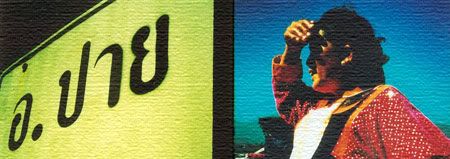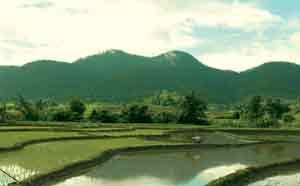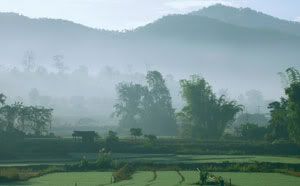Link::From Wikipedia, the free encyclopedia
Pai (Thai: ปาย) is a small town in northern Thailand near the Myanmar border, north of Chiang Mai on the northern route to Mae Hong Son. It lies along the Pai River. The town has thesaban tambon status and covers parts of the tambon Wiang Tai of Pai district। As of 2006 it has a population of 2,284। Access
Access
Pai is located on Thai highway 1095, which connects Mae Hong Son with Chiang Mai. The Pai Airport, which had been decommissioned for 20 years, was paved and refurbished in 2005-6, and on 1 February 2007, Siam General Aviation began daily passenger service to and from Chiang Mai International Airport.
Tourism and Development
Pai was once a quiet market village inhabited by Shan people (ethnic Tai whose culture is influenced by Burma; see the History section below), but nowadays Pai primarily thrives on tourism. Well-known among backpackers for its relaxed atmosphere, the town is full of cheap guesthouses, souvenir shops and restaurants. In the proximity of the town are spas and elephant camps. Further outside of town, there are several waterfalls and a number of natural hot springs varying in temperature from 80 to 200 degrees Celsius. Some resorts tap the hot springs and feed hot water into private bungalows and public pools. As Pai lies at the foot of the mountains, many tourists use it as a base for trekking and visiting hill tribes like Karen, Hmong, Lisu and Lahu. Another notable attraction is the town's excellent Wednesday Market which brings large and colorful crowds of local villagers and tribal people from all around the Pai Valley.
Recently Pai has appeared on the Thailand tourist map and has received major infrastructure upgrades including an airport with several daily flights, two 7/11's, several small- to medium-size luxury resorts (adding to the more than 118 guesthouses and restaurants which existed as of June 2007[2]), a couple of live music clubs, beer bars and two sets of traffic lights. This has done little to dampen the small and peaceful spirit of the town out of season. However, it has led to a recent influx of business investment and land speculation by both farang (non-Asian foreigners) and big city Thais. While some hail these sweeping changes as a new age of prosperity for Pai, others point to the loss of Pai's traditional customs and culture.[3][4]
In the tourist high season of November through March there are large numbers of tourists. Prior to 2006, foreign tourists predominated, but now Thai tourists make up the vast majority, particularly after Pai featured in two popular, Thai-made romantic movies, The Letter: Jod Mai Rak (Thai: จดหมายรัก, 2004) and Ruk Jung (Thai: รักจัง, 2006).
Pai has music festivals regularly as well as staging an International Enduro Championship।
History
Unless otherwise indicated, the information in this section is based on local Pai resident Thomas Kasper's history of Pai:
The area of modern-day Pai has been inhabited for more than 5,000 years. About 2,000 years ago, the Lua (or Lawa) Tribe was the dominant ethnic group all over the area of today's northern Thailand, and a few of their descendants still live in villages only about 20km away from Pai.
The recorded history of the area starts about 800 years ago with the establishment of a settlement (today known as Ban Wiang Nuea) about 3km north of modern-day Pai. Ban Wiang Nuea was founded in 1251 AD by Shan immigrants from the region of modern-day northern Burma. Due to the area's remoteness and seclusion, people in those times were mainly cut off from news of the outside world and therefore not much concerned with the politics of Lanna and the rest of Thailand. That changed drastically in the course of the 14th and 15th century, when the first settlers arrived from Chiang Mai. It was part of Lanna policy of the time to send citizens loyal to the Lanna throne to the outposts of the empire, in order to consolidate and affirm Lanna's territorial authority। The result was a conflict that eventually led to a series of wars over territorial dominance in the Pai area. The Lanna troops finally defeated the Shan soldiers in 1481, forcing them to retire to Burmese territory. The Shan families who had lived in the area for a long time, establishing households, farming their land and raising their families, were granted permission to stay by the Lanna prince, along with a certain degree of cultural and social autonomy under the law and authority of the Lanna kingdom. Ban Wiang Nuea as a result became a village sharply divided into two parts by a wall into a "Shan" part and a "Lanna" part.
In the second half of the 19th century, colonial powers France and England, who had already established their influence in Vietnam, Cambodia, Laos and Burma, were viewing the area of modern-day Thailand with increasing interest. To consolidate Siam's influence and authority in the northern border region, the royal house encouraged Northern Thais from provinces like Payao, Lamphun and Nan to migrate to those areas. The result again was conflict: the last fight between Lanna Thai and Shan in Ban Wiang Nuea took place in 1869, when Lanna soldiers finally defeated their Shan opponents in a battle that ended with the total destruction of the village. The entire village was burnt to the ground. All structures standing in Ban Vieng Nuea today are the result of the subsequent rebuilding efforts of the villagers.
There was already a "road" (that took up to a week to traverse) leading from Chiang Mai to Pai in the late 19th century. Many of the new immigrants chose to settle in the area of the connecting road to Mae Hong Son, south of the village of Ban Wiang Nuea. This settlement was known as Ban Wiang Tai, and it developed into the modern town we know as Pai.
During World War Two, the Japanese began several projects to create efficient troop and equipment transport routes between Thailand and Burma, and (in addition to the well-known Death Railway through Kanchanaburi) one of these projects was the improvement of the existing "road" from Chiang Mai through Pai and Mae Hong Son. A wood and steel bridge built by the Japanese still stands about 10 km from Pai on the road to Chiang Mai, just parallel to the bridge later built in the course of more recent road improvement projects by the Thai government. As it turned out, just about when the Japanese supply line reached Burma, the war was over.
The Thai government started developing the road leading from Chiang Mai via Pai to Mae Hong Son, known today as Highway 1095, in 1967, but didn't finish paving the route until the early- to mid-1990s।
Pai's recent history is one of waves of migration: in addition to the aforementioned waves of old Shan and Lanna immigrants, Karen immigrants arrived in the 18th century, Lisu and Lahu people from areas of southern China arrived in the early 20th century, Muslim families from Chiang Mai began arriving to establish trade businesses starting around 1950, a group of Kuomintang fleeing Mao Zedong established a community in Pai in the early 1960s, and finally a new wave of refugees from the Shan State of Burma have arrived in the last few decades, fleeing the turmoil caused by the Burmese Junta to work as laborers in Thailand।
Link::From Wikipedia, the free encyclopediaOther links::Pai, Thailand02
Canyon Land in Pai, Thailand




0 Comments:
Post a Comment